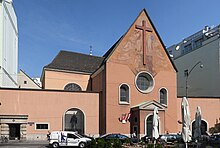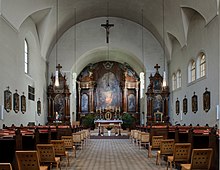Capuchin Church (Vienna)
The Church of Saint Mary of the Angels is a Roman Catholic church in the Capuchin Monastery in Vienna's 1st district, Inner City . The Vienna Capuchin Monastery and its church are particularly known for the Capuchin Crypt , which served as the burial place of the ruling house of the Habsburgs for centuries .
history

The Viennese Capuchin monastery with church and crypt was founded in 1618 by Empress Anna (1585–1618), the wife of Emperor Matthias (1557–1619), in a will. Under Ferdinand II. (1578–1637) the foundation stone was laid on September 8, 1622 at what was then the flour market or at the flour pit . Due to the Thirty Years War , work was delayed and the church could not be completed until 1632. The new, simply designed church with its gable facade stood out clearly from the surrounding aristocratic and town houses. During the second Turkish siege of Vienna in 1683, the roof structure was destroyed by Turkish shelling.
In the course of time the church has been subjected to numerous renovations, the most striking is the porch from 1760.
In the years 1934 to 1936 the facade of the church was reconstructed according to historical pictures and provided with a fresco by Hans Fischer. The monument of Marco d'Aviano by the hand of the Viennese sculptor Hans Mauer , which is located on the outside of the church , also dates from this time .
The interior of the church was completely renovated in 1976.
In 2016 the church was completely renovated under the Provincial Lech Siebert and the architect Thomas Tschemer. The measures included the entire interior of the church as well as the complete renovation of the facade and the church roof. The church heating and the entire electrical installation as well as the lighting in the church were also renewed. In the course of the renovation of the church floor and the demolition of the Metlacher slabs from 1905, the sandstone floor slabs, Kelheim slabs, were discovered and released under the church pews. They are now in the shape of a cross in the square of the pews. In the building history survey by Guenther Buchinger there are drawings that date this panel division to the year 1823. The floor of the imperial chapel was also reconstructed according to this drawing and now shows the diagonal chessboard laying again. The new laying in the nave was done with Untersberg marble. The fresco of the gable facade could still be extensively restored, as well as the basic color in red and ocher. The remaining facades were painted off-white; The colored step on the side walls makes the pre-blinded gable facade and the end of the baroque structure visible.
Architecture and equipment

The simple single-nave hall church of the Vienna Capuchin Monastery has a barrel vault as well as a small vestibule and two side chapels: the Imperial Chapel (left) and the Pietà Chapel (right).
Longhouse
Most of the paintings in the nave of the church were made by Norbert Baumgartner .
On the walls of the church, especially below the organ gallery, there are numerous memorial plaques for units of the Austro-Hungarian army, including the Kuk Galician Uhlan Regiment No. 13 .
To the right of the entrance to the nave, under the organ gallery, there is also one of the exits to the Capuchin Crypt . The stone stairs to the crypt can be reached from the church via a wooden portal, which is usually locked.
Imperial Chapel
In contrast to the simple design of the rest of the monastery church, the imperial chapel, which is extremely splendidly furnished, contains a series of life-size statues of regents from the Habsburg family in addition to the high altar with a particularly venerated picture of Mariahilf . The chapel has repeatedly received donations from the imperial family. In later times the chapel developed into an important inner-city pilgrimage site for the Viennese and the nobility.
In the area under the Imperial Chapel is the so-called Founder's Crypt , the oldest part of the Capuchin Crypt , in which the lead coffins of Emperor Matthias and Empress Anna are.
The last Austro-Hungarian heir to the throne, Otto von Habsburg , who died in July 2011, was laid out together with his wife Regina von Sachsen-Meiningen in the Capuchin Crypt in the Imperial Chapel before their burial.
Pietà Chapel
In the Pietà Chapel there has been a marble altar with a life-size Pietà, created by Peter Strudel and originally placed in the Capuchin Crypt , since the end of the 18th century . In the floor in front of the altar is the grave of Blessed Marco d'Aviano , as well as that of the Capuchin General Minister Paul von Colindres, who died in Vienna in 1766 .
organ
The Capuchin Church has an organ that is placed on the west gallery of the nave. In the course of the general renovation in 2016, the organ built in 1893 in neoclassical style by the Rieger brothers (Jägerndorf) was dismantled and replaced by a baroque-style organ from Koenig facteurs d`orgues. The organ consecration took place on October 8, 2017.
Composition des jeux 2017
|
|
|
|||||||||||||||||||||||||||||||||||||||||||||||||
- Coupling : II / I, I / P, II / P.
Web links
Individual evidence
- ↑ Hans Vollmer (Ed.): General Lexicon of Fine Artists of the XX. Century . Leipzig 1930, Volume 24, p. 274.
- ↑ see also on commons.wikimedia.org , accessed on December 28, 2012.
- ^ Otto Habsburg laid out in the Kapuzinerkirche on derstandart.at, July 14, 2011, accessed on December 28, 2012.
- ^ Günther Buchinger, Christa Farka: Vienna: I. District - Inner City. Institute for Austrian Art Research of the Federal Monuments Office, Vienna 2003, ISBN 3-85028-366-6 , p. 81; (Detail scan)
Coordinates: 48 ° 12 ′ 20.5 ″ N , 16 ° 22 ′ 10.2 ″ E




